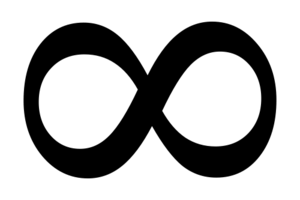Unendlich
Zur Navigation springen
Zur Suche springen
Definitionen
In den verschiedenen Quellen gibt es unterschiedliche Definitionen des Begriffs Unendlich:
Allgemein
- Der Begriff Unendlichkeit bezeichnet die Negation bzw. Aufhebung von Endlichkeit, weniger präzise auch deren „Gegenteil“ (Quelle).
- Das Unendliche – im Sinne von: das Nichtendliche – ist der direkten menschlichen Erfahrung unzugänglich und am ehesten mit dem Begriff der unbegrenzten Weite zu assoziieren (Quelle).
In der Fotografie
- Wenn das Motiv unendlich (oder nahezu unendlich) weit entfernt ist, zum Beispiel bei einer Landschaftsaufnahme, ist der notwendige Abstand des Objektivs vom Film (genauer: der Abstand der bildseitigen Hauptebene des Objektivs vom Film) gleich der Objektivbrennweite (Quelle).
- Entspricht die Brennweite des Objektivs der Bildweite, so werden Objekte scharf abgebildet, die unendlich weit entfernt sind. Die Lichtstrahlen, die von einem unendlich weit entfernten Punkt ausgehen, treten parallel ins Objektiv ein. Mathematisch ist unendlich durch den Zerstreuungskreisdurchmesser und die Brennweite definiert: Ein Objektpunkt gilt als unendlich weit entfernt, wenn seine Gegenstandsweite größer als die 1.500-fache Brennweite ist. Das sind bei einem 50-mm-Kleinbildobjektiv 75 Meter (Quelle: Claus Militz, Urs Tilmanns - Leica Fotoschule, ISBN 3-7231-6300-9).
Zitate
Einige Zitate aus dem DSLR-Forum:
- "Unendlich beginn in der Fotografie bei der 'Hyperfokalen Distanz'. Das ist die Distanz ab der das Objektiv bei einer bestimmten Blende alles bis Unendlich scharf stellt! Sie ist von der Kamera (besser Sensorgröße und Auflösung), der Blende und der Brennweite abhängig.
im Allgemeinen wird davon ausgegangen, daß ein Objektiv in einem Abstand von ca. 10000 - 15000 - facher "Brennweitenentfernung" "Unendlich erreicht > Beispiel: bei einer Brennweite von 18 mm sollte der "Unendlich" - Punkt bei ca. 18000 mm bis 27000 mm liegen."
Ein schönes Zitat von Michael J. Hußmann aus dem l-camera-forum:
- "In the good old times before the advent of fast computers, lenses were optimized for infinity focus. Not because anyone believed that infinity was what lenses were most often focused at, but just to simplify the already quite complex calculations and to reduce the number of those calculations. These days this isn't necessary anymore; one can optimize lenses for more typical subject distances which for many lenses might be 2 to 5 meters, say, rather than infinity. But of course the typical subject distance depends on the lens and will differ between a portrait lens and an extreme telephoto lens used by wildlife photographers. In the case of the lenses for the S2, Leica claims they optimize performance nor for one but for all distances, although there will always be a distance where performance reaches a maximum and one would strive to achieve this peak performance at a subject distance typical for that lens.
Just as an aside: Reading this thread I got the expression that infinity is seen as something that can only be approximated. To quote from the Hitchhiker's Guide to the Galaxy: “INFINITE: Bigger than the biggest thing ever and then some. Much bigger than that in fact, really amazingly immense, a totally stunning size, real 'wow, that's big,' time. Infinity is just so big that by comparison, bigness itself looks real titchy. Gigantic multiplied by colossal multiplied by staggeringly huge is the sort of concept we're trying to get across here.” But as far as focusing lenses is concerned, there is no need to approximate. When the distance between the lens (or actually its rear principal plane) and the sensor (or film) equals the focal length, the lens is focused at infinity, ie parallel light rays hitting the lens will converge in the sensor/film plane. That's what the infinity mark indicates: at that mark, the image distance is equal to the focal length. If a lens manufacturer wants to test for this, they wouldn't bother with something at 1000 xf, a belfry in the next village, or a bright star – they will use a collimated laser beam. Parallel light rays from a subject at infinity are created on a lab table. Only the photographer who is typically lacking such equipment would ever need to rely on approximations. The factor by which to multiply the focal length depends on our resolution requirements, ie which CoC is capturing our notion of acceptable sharpness. 1000 xf was a useful rule of thumb for moderately fast lenses (not for a Noctilux) when a 30 µm CoC was deemed adequate, but not anymore (as we have seen)."
Weblinks
